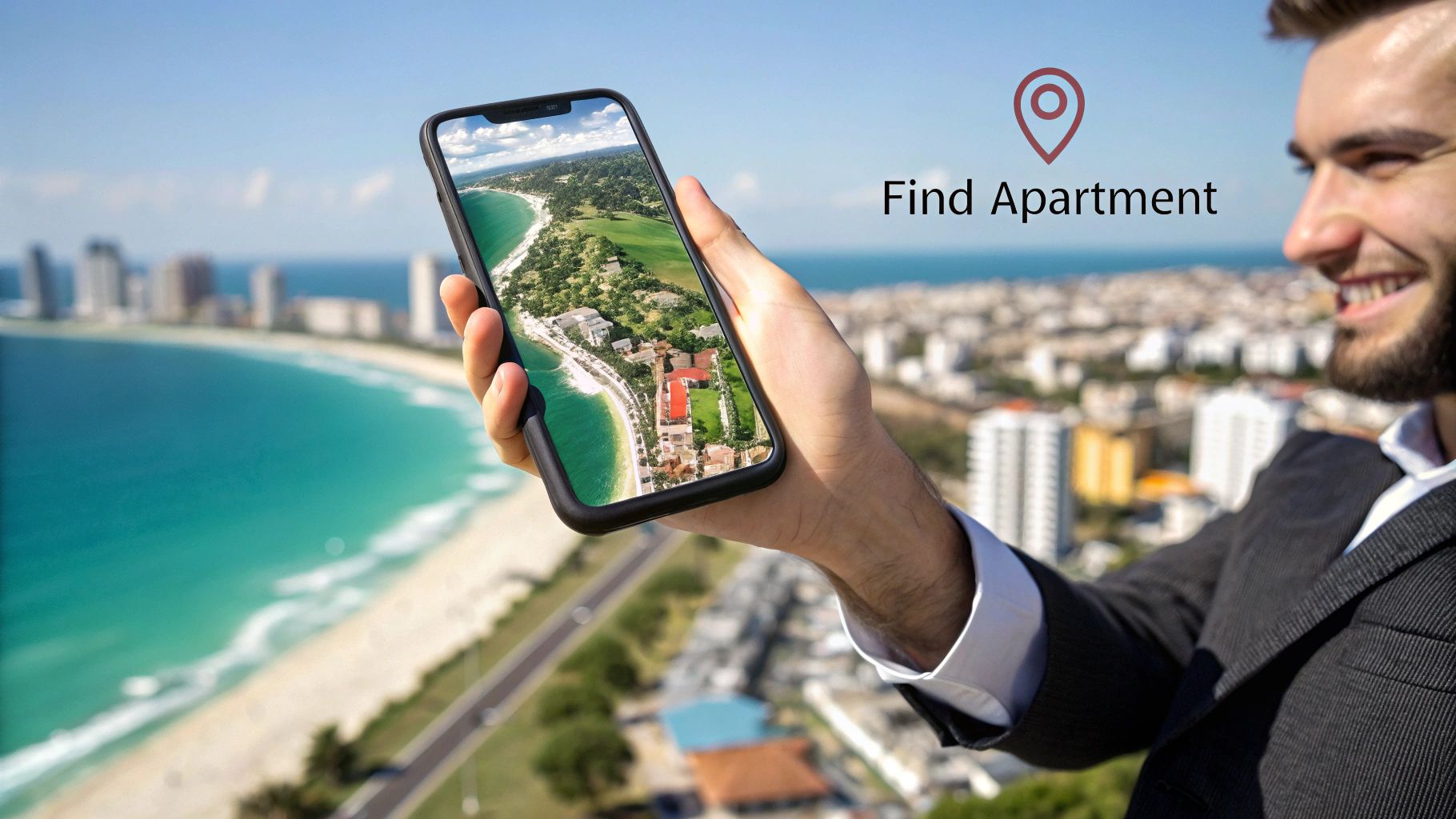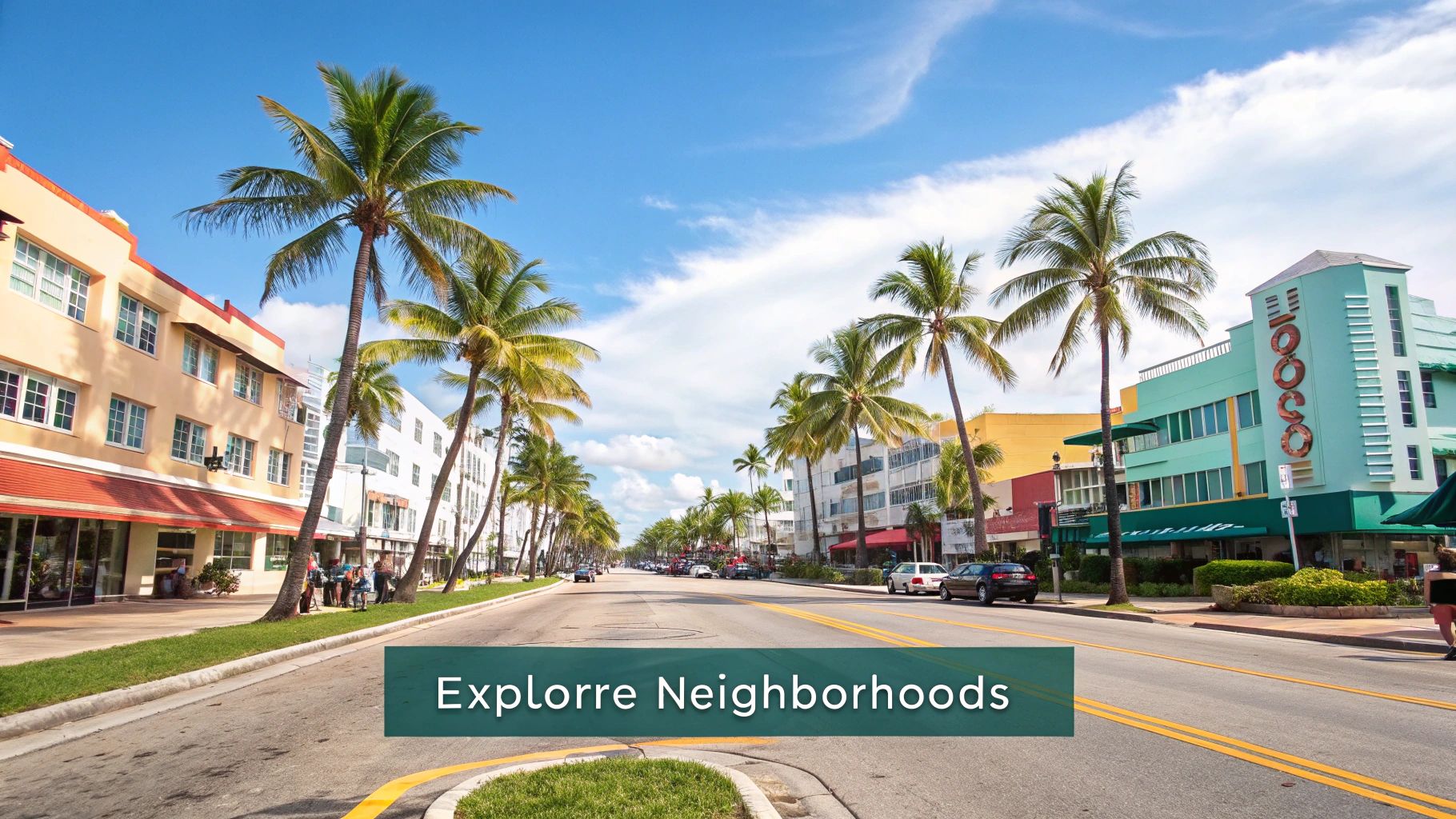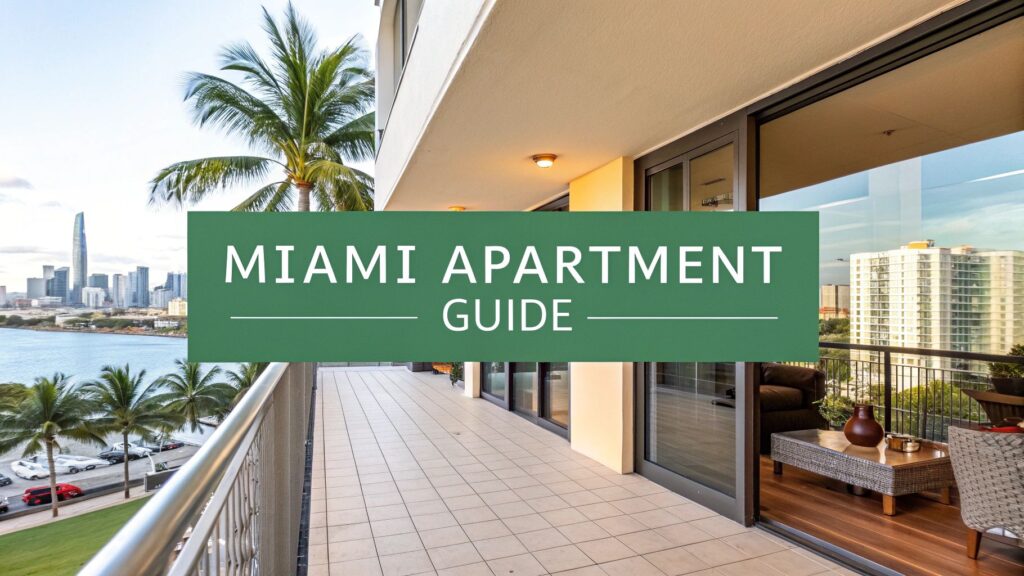So, you're looking for an apartment rental in Miami. Get ready, because you’re jumping into one of the most exciting and fast-paced rental markets in the entire country. To come out on top, you'll need a solid budget, a good feel for the neighborhoods, and a plan to act fast when you find the one.
Cracking the Miami Apartment Rental Market

Welcome to the wild ride of renting in Miami. It’s a city that moves to its own beat, and the rental market is no different. Unlike a lot of other places, Miami is a true renter's town. Demand is always through the roof, and the best places can be gone in a flash—sometimes just hours after they're listed.
Let's talk numbers for a second to get a clear picture. As of early 2024, the average rent hovers around $2,727 a month for a place that's roughly 890 square feet. What really drives this home is that nearly 69% of all households in Miami are renter-occupied. That single stat tells you everything you need to know about how competitive things are. For a deeper dive, I always recommend checking out the market trends on platforms like RentCafe.com.
Winning in this market isn't about endlessly scrolling through listings. It's about being prepared. Getting your finances straight from the start is your first and most important move.
Setting a Realistic Budget
Before you start dreaming about that ocean-view balcony in Brickell, you need to get real about your budget. It’s the single most important step. What you can afford changes dramatically from one block to the next, so knowing your numbers keeps your search focused and prevents a lot of heartache later. A budget that lands you a huge one-bedroom in Kendall might barely get you a small studio in South Beach.
To give you a head start, here’s a quick breakdown of what you can expect to pay for different types of apartments around the city.
Miami Apartment Rental Budget Snapshot
This table offers a quick look at average monthly rents for different apartment types in Miami, which should help you set a realistic budget.
| Apartment Type | Average Rent Range | Best For |
|---|---|---|
| Studio | $2,000 – $2,800 | Solo renters or students looking for a compact, efficient living space. |
| 1-Bedroom | $2,500 – $3,500 | Young professionals or couples needing a bit more room and separation of space. |
| 2-Bedroom | $3,200 – $5,000+ | Roommates or small families who need an extra bedroom or a home office. |
Keep in mind, these are just averages. A brand-new building with a rooftop pool will be on the higher end, while an older walk-up might be more affordable. Use this as your starting point to figure out what’s truly possible for you.
Building Your Miami Rental Budget and Wishlist
Before you even think about scrolling through apartment listings, let's talk prep work. Jumping into the Miami rental market without a solid plan is a recipe for frustration. A successful apartment hunt starts with two things: a realistic budget and a clear-eyed wishlist.
One of the biggest surprises for renters, especially those new to Miami, is the hefty upfront cost. We're not just talking about the first month's rent. In this market, it's standard practice to put down the first month's rent, last month's rent, and a security deposit (which is usually another month's rent).
So, for that dream apartment listed at $2,800 a month, you'll likely need $8,400 in cash just to secure the lease and get the keys. Being prepared for this reality is half the battle.
This image breaks down the key financial steps to consider when planning your move.

As you can see, the monthly rent is just the starting point. Factoring in utilities, moving expenses, and that big security deposit gives you a much more accurate picture of what you truly need.
Getting Your Paperwork in Order
Landlords and property managers need to know you're a reliable tenant, and they have a pretty standard way of checking. The most common benchmark is the "3x rent" income rule. This means your gross monthly income should be at least three times the rent. Using our $2,800 apartment example, you'd need to prove you make at least $8,400 per month.
The Miami market moves fast. When you find a place you love, you won't have time to go digging for documents. Have a digital folder ready to go with these essentials:
- Proof of Income: Your last two or three pay stubs. If you're starting a new job, an official offer letter works, too.
- Bank Statements: A couple of recent statements to show you have the funds for the move-in costs.
- Photo ID: A clear copy of your driver's license or other government-issued ID.
- Rental History: Names and contact information for your previous landlords. They will be called!
Your budget gets you in the door, but your wishlist ensures you'll be happy once you're inside. Seriously, take ten minutes to make a "must-have" vs. "nice-to-have" list. It will save you hours of wasted time.
Think about your non-negotiables. If you work from home, maybe a separate den or alcove for an office is a must-have. A resort-style pool might be a nice-to-have. If you don't have a car, living within a 10-minute walk of a Metrorail station is a critical need, not just a preference. Getting honest about these priorities is the secret to a focused, efficient, and ultimately successful search for an apartment rental in Miami.
Finding Your Perfect Miami Neighborhood

Let's be real: Miami isn't just one place. It's a patchwork quilt of incredibly diverse districts, each with its own vibe, rhythm, and personality. Finding the right apartment rental Miami can offer starts with finding the neighborhood that clicks with you. This decision will shape your daily commute, your weekend adventures, and your overall happiness, so it pays to get it right.
Start by thinking about what your ideal day-to-day looks like. Do you see yourself in the heart of the action, surrounded by towering skyscrapers and a work-hard-play-hard crowd? If so, Brickell might be your speed. This is Miami’s financial center, brimming with sleek condos, buzzing rooftop bars, and ambitious young professionals. The trade-off, of course, is a higher price tag and the constant energy of a major urban core.
Maybe you’re after something a bit more timeless and tranquil. The gorgeous, tree-canopied streets and historic Mediterranean architecture of Coral Gables offer a totally different feel—it's elegant, established, and a world away from the downtown hustle.
And for the creative souls? Wynwood is practically a rite of passage. It's an explosion of color and culture, famous for its incredible street art, unique boutiques, and some of the trendiest restaurants in the city. On the flip side, if your perfect day involves sun, sand, and surf, the world-famous Art Deco playground of South Beach delivers an iconic lifestyle. Just be prepared for premium rents and a steady stream of tourists.
Matching Your Lifestyle to a Location
To really dial in your search, it helps to put these areas head-to-head. Think practically about how each one fits your budget and what you need to do every day. It's less about picking the "coolest" spot and more about finding the one that makes your life easier and more enjoyable.
| Neighborhood | Vibe & Lifestyle | Ideal For |
|---|---|---|
| Brickell | Financial district hustle, luxury high-rises, upscale dining. | Ambitious professionals and finance experts. |
| Wynwood | Artistic, eclectic, and trend-setting. | Creatives, entrepreneurs, and culture lovers. |
| South Beach | Iconic beach life, nightlife, and art deco glamour. | Beach enthusiasts and social butterflies. |
| Coral Gables | Historic, elegant, and family-oriented. | Those seeking a quieter, more refined setting. |
The key is to spend time in your top-choice neighborhoods before committing. Grab a coffee, walk around on a weekday afternoon and a weekend night. Get a feel for the traffic, the noise levels, and the local community.
Choosing where to live is a huge decision that goes way beyond your mailing address. Sometimes, looking just outside the city proper can uncover fantastic alternatives. If you're open to exploring nearby communities, you might find a better balance of cost, space, and lifestyle. To get a feel for what’s out there, check out our guide on why Boca apartments are hidden gems in the current market.
Strategies for a Successful Apartment Hunt
Alright, you've got your budget dialed in and a few neighborhoods on your radar. Now for the fun part: actually finding your new place. Hunting for an apartment rental in Miami isn't for the faint of heart. The market moves at lightning speed, and the best places can get snapped up within hours of hitting the web. You have to be ready to act fast.
Your search will live and die on the big rental websites. Don't just scroll when you have a spare moment; you need a game plan. The most powerful weapon in your arsenal is the instant alert. Set up your search filters—neighborhoods, price, must-haves like in-unit laundry or a balcony—on a few different platforms. The moment a new apartment that fits your criteria is listed, you'll get a notification. This is how you become one of the first people to call.
Timing is Everything in the Miami Market
Knowing how the city’s rental calendar works can give you a real leg up. Miami’s market is incredibly seasonal. The busiest, most competitive time is late spring through summer, when everyone from new grads to relocating professionals floods the city.
If you have some wiggle room with your move-in date, try to aim for the fall or winter. You’ll generally find more options, a little less competition, and maybe even a better deal. It's a much less frantic experience.
The numbers don't lie: Miami's rental market has gotten tighter over the years. The vacancy rate plummeted from a high of 11.40% in 2009 to just 5.28% by 2019. With fewer units available, you really have to be prepared to move quickly when you find a place you love. You can dig into more data on Miami-Dade's rental market dynamics to see the trends for yourself.
When you finally get to see a place in person, think like a detective, not just a future tenant. It's easy to get wowed by a great view, but the little things are what make a place livable.
Bring a mental checklist and pay attention to the details:
- Check your cell service. Walk around the apartment and see if you have bars everywhere. A dead zone in your own home is a modern-day nightmare.
- Test the water pressure. Turn on the shower and the kitchen sink. Weak water pressure is one of those small annoyances that can drive you crazy over time.
- Look for water damage. Scan the ceilings, especially in corners and under sinks, for any discoloration or bubbling paint.
- Listen. If you can, try to visit at different times. Is the upstairs neighbor a tap dancer? Does rush hour traffic sound like it's in your living room?
Decoding and Signing Your Miami Lease

So, you’ve found the one. Now comes the most crucial part of landing your Miami apartment: the lease agreement. It’s a legal document, and yes, it can look a little intimidating. But think of it this way—understanding what you’re signing is your best defense against any headaches down the road.
Before that lease even hits your inbox, you'll tackle the application. Be prepared for a thorough background and credit check; it’s standard procedure in a market this hot. My advice? Have all your documents organized and ready to go. It makes you look like a serious, prepared applicant who won’t waste anyone’s time.
This isn’t surprising when you look at the numbers. Miami has increasingly become a city of renters. The share of renter-occupied homes climbed from 33.8% in 2005 to over 40% by 2019, putting it way above state and national averages. You can dig into the data on Miami renter demographics to see the full picture.
Key Clauses to Scrutinize
Once that lease is in your hands, don't just skim it. Pour yourself a coffee, sit down, and actually read it—every single line. I’ve seen tenants get into trouble by glossing over the fine print. Pay special attention to these areas:
- Landlord's Right of Entry: This spells out when and how your landlord can enter your apartment. Know what they consider "reasonable notice" for things like inspections or repairs.
- Subletting Rules: Thinking about getting a roommate later or renting your place out on Airbnb while you travel? Check this clause first. Many leases have very strict rules about this, and some forbid it entirely.
- Early Termination Penalties: Life is unpredictable. If you have to break your lease, what’s the damage? These penalties can be steep, so you need to know exactly what you’d be on the hook for.
Knowing what's standard versus what's negotiable gives you a huge advantage. The monthly rent is almost never flexible in this market, but you might be able to negotiate smaller details, like getting a better parking spot or asking for minor cosmetic fixes before you move in.
If you want to dive deeper, our guide on Boca Raton apartment lease agreements offers key insights that are relevant to most standard Florida leases. A little time spent understanding your lease now can save you a world of trouble later.
Your Top Miami Rental Questions, Answered
Jumping into the Miami rental market can feel like learning a new language. You’ve got questions, and getting straight answers is the only way to feel confident and avoid the classic rookie mistakes. Let's tackle some of the most common things people ask when looking for an apartment rental in Miami.
The first thing that trips people up is the paperwork. Miami landlords don't wait around. If you’re serious, you need to prove it. Before you even schedule your first viewing, get a digital folder organized. You'll want your government-issued ID, your last few pay stubs to show your income, and a couple of recent bank statements. Showing up prepared like this immediately puts you at the top of the list.
What's the Real Upfront Cost?
This is where sticker shock often sets in. It's never just the first month's rent. The standard move-in cost in Miami is the first month's rent, the last month's rent, and a security deposit that’s usually equal to another month's rent.
So, if you’re looking at a $2,800 apartment, you need to have $8,400 ready to go just to secure the lease and get your keys. It's a hefty sum, so planning for it is crucial.
Another big question is always about pets. You'll find plenty of pet-friendly buildings, but almost every single one will have rules about size or specific breeds. You should also budget for a non-refundable pet fee or even monthly "pet rent." Always, always ask about the specific pet policy before you waste time and money on an application.
Getting to know the local vibe is also part of finding the right home. Seeing how local organizations contribute to the community gives you a feel for the area's character. For instance, understanding how the Community Foundation for Palm Beach and Martin Counties hosts events highlights the active and engaged spirit you'll find all across South Florida.
Ready to find a serene and affordable home base in South Florida? Discover the perfect one-bedroom apartment at Cynthia Gardens, ideally located in Boca Raton near beautiful beaches and top universities. Explore our available units today!
